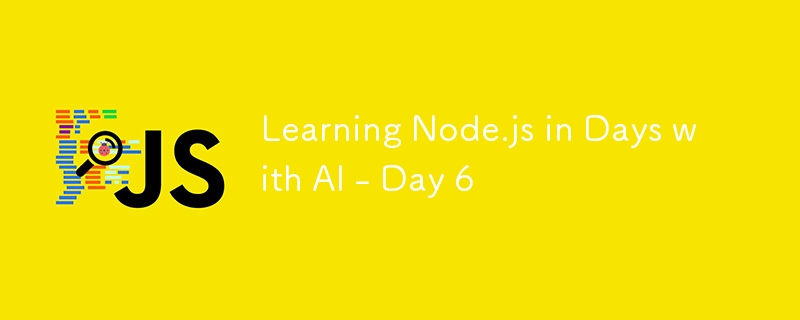利用 AI 快速学习 Node.js - 第 6 天

今天是我 Node.js 学习冒险的第六天,我深入研究了 EventEmitter 类的迷人世界。以下是我如何浏览它以及我在此过程中学到的东西。
理论回顾
EventEmitter 类是 Node.js 中用于管理事件的基石。它提供了一种强大的方法来创建、发出和处理事件,这对于构建依赖事件驱动架构的应用程序至关重要。
EventEmitter 的关键方法:
- on(eventName,listener):为特定事件注册监听器。
- emit(eventName, [...args]):发出事件,将可选参数传递给侦听器。
- removeListener(eventName,listener):删除事件的特定监听器。
- once(eventName,listener):添加仅触发一次的监听器。
实际任务
任务: 创建自定义事件和处理程序。
我首先创建一个扩展 EventEmitter 的类并添加自定义事件处理程序。这是我所做的一步一步的说明:
- 定义自定义类:
我创建了一个名为 DataProcessor 的类,它扩展了 EventEmitter。这个类有一个 processData 方法来模拟数据处理。
const EventEmitter = require('events');
class DataProcessor extends EventEmitter {
processData(data) {
this.emit('start');
// Simulate data processing
setTimeout(() => {
this.emit('data', data);
this.emit('end');
}, 1000);
}
}
- 设置事件处理程序:
然后,我初始化了 DataProcessor 类并为三个事件定义了处理程序:“start”、“data”和“end”。
// Initialization
const processor = new DataProcessor();
// Event handlers
processor.on('start', () => console.log('Processing started...'));
processor.on('data', (data) => console.log(`Processing data: ${data}`));
processor.on('end', () => console.log('Processing completed.'));
- 发出的事件:
最后,我调用了 processData 方法来查看正在运行的事件。
processor.processData('Some data');
看着事件的发生顺序是有启发性的。控制台输出显示了从启动流程到处理数据并完成的流程。
独立任务
任务:使用事件开发通知系统。
对于独立任务,我设计了一个Notifier类。以下是我的处理方法:
- 创建了通知程序类:
const EventEmitter = require('events');
class Notifier extends EventEmitter {
constructor() {
super();
this.notifications = [];
}
addNotification(notification) {
if (typeof notification !== 'string') {
this.emit('error', 'Notification must be a string');
return;
}
this.notifications.push(notification);
this.emit('notify', notification);
if (this.notifications.length > 0) {
this.emit('complete');
}
}
}
- 定义的事件处理程序:
我设置了“通知”、“错误”和“完成”的处理程序。
const notifier = new Notifier();
notifier.on('notify', (message) => console.log(`New notification: ${message}`));
notifier.on('error', (err) => console.error(`Error: ${err}`));
notifier.on('complete', () => console.log('All notifications processed.'));
- 测试系统:
我通过添加通知和处理潜在错误来测试系统。
notifier.addNotification('This is your first notification.');
notifier.addNotification('This is your second notification.');
notifier.addNotification(123); // This should trigger an error
看到如何处理通知、报告错误以及触发完成事件是令人满意的。
结论
今天对 EventEmitter 的探索极大加深了我对 Node.js 事件驱动编程的理解。实现自定义事件和处理程序是了解事件如何流动以及如何有效管理事件的好方法。这次独立任务进一步强化了这些概念,并让我获得了构建通知系统的实践经验。
我很高兴能继续这个旅程,看看接下来的几天会发生什么!
资源
ChatGPT 创建的所有课程都可以在以下位置找到:https://king-tri-ton.github.io/learn-nodejs
以上是利用 AI 快速学习 Node.js - 第 6 天的详细内容。更多信息请关注PHP中文网其他相关文章!

热AI工具

Undresser.AI Undress
人工智能驱动的应用程序,用于创建逼真的裸体照片

AI Clothes Remover
用于从照片中去除衣服的在线人工智能工具。

Undress AI Tool
免费脱衣服图片

Clothoff.io
AI脱衣机

Video Face Swap
使用我们完全免费的人工智能换脸工具轻松在任何视频中换脸!

热门文章

热工具

记事本++7.3.1
好用且免费的代码编辑器

SublimeText3汉化版
中文版,非常好用

禅工作室 13.0.1
功能强大的PHP集成开发环境

Dreamweaver CS6
视觉化网页开发工具

SublimeText3 Mac版
神级代码编辑软件(SublimeText3)
 Python vs. JavaScript:学习曲线和易用性
Apr 16, 2025 am 12:12 AM
Python vs. JavaScript:学习曲线和易用性
Apr 16, 2025 am 12:12 AM
Python更适合初学者,学习曲线平缓,语法简洁;JavaScript适合前端开发,学习曲线较陡,语法灵活。1.Python语法直观,适用于数据科学和后端开发。2.JavaScript灵活,广泛用于前端和服务器端编程。
 JavaScript和Web:核心功能和用例
Apr 18, 2025 am 12:19 AM
JavaScript和Web:核心功能和用例
Apr 18, 2025 am 12:19 AM
JavaScript在Web开发中的主要用途包括客户端交互、表单验证和异步通信。1)通过DOM操作实现动态内容更新和用户交互;2)在用户提交数据前进行客户端验证,提高用户体验;3)通过AJAX技术实现与服务器的无刷新通信。
 JavaScript在行动中:现实世界中的示例和项目
Apr 19, 2025 am 12:13 AM
JavaScript在行动中:现实世界中的示例和项目
Apr 19, 2025 am 12:13 AM
JavaScript在现实世界中的应用包括前端和后端开发。1)通过构建TODO列表应用展示前端应用,涉及DOM操作和事件处理。2)通过Node.js和Express构建RESTfulAPI展示后端应用。
 了解JavaScript引擎:实施详细信息
Apr 17, 2025 am 12:05 AM
了解JavaScript引擎:实施详细信息
Apr 17, 2025 am 12:05 AM
理解JavaScript引擎内部工作原理对开发者重要,因为它能帮助编写更高效的代码并理解性能瓶颈和优化策略。1)引擎的工作流程包括解析、编译和执行三个阶段;2)执行过程中,引擎会进行动态优化,如内联缓存和隐藏类;3)最佳实践包括避免全局变量、优化循环、使用const和let,以及避免过度使用闭包。
 Python vs. JavaScript:社区,图书馆和资源
Apr 15, 2025 am 12:16 AM
Python vs. JavaScript:社区,图书馆和资源
Apr 15, 2025 am 12:16 AM
Python和JavaScript在社区、库和资源方面的对比各有优劣。1)Python社区友好,适合初学者,但前端开发资源不如JavaScript丰富。2)Python在数据科学和机器学习库方面强大,JavaScript则在前端开发库和框架上更胜一筹。3)两者的学习资源都丰富,但Python适合从官方文档开始,JavaScript则以MDNWebDocs为佳。选择应基于项目需求和个人兴趣。
 Python vs. JavaScript:开发环境和工具
Apr 26, 2025 am 12:09 AM
Python vs. JavaScript:开发环境和工具
Apr 26, 2025 am 12:09 AM
Python和JavaScript在开发环境上的选择都很重要。1)Python的开发环境包括PyCharm、JupyterNotebook和Anaconda,适合数据科学和快速原型开发。2)JavaScript的开发环境包括Node.js、VSCode和Webpack,适用于前端和后端开发。根据项目需求选择合适的工具可以提高开发效率和项目成功率。
 C/C在JavaScript口译员和编译器中的作用
Apr 20, 2025 am 12:01 AM
C/C在JavaScript口译员和编译器中的作用
Apr 20, 2025 am 12:01 AM
C和C 在JavaScript引擎中扮演了至关重要的角色,主要用于实现解释器和JIT编译器。 1)C 用于解析JavaScript源码并生成抽象语法树。 2)C 负责生成和执行字节码。 3)C 实现JIT编译器,在运行时优化和编译热点代码,显着提高JavaScript的执行效率。
 Python vs. JavaScript:比较用例和应用程序
Apr 21, 2025 am 12:01 AM
Python vs. JavaScript:比较用例和应用程序
Apr 21, 2025 am 12:01 AM
Python更适合数据科学和自动化,JavaScript更适合前端和全栈开发。1.Python在数据科学和机器学习中表现出色,使用NumPy、Pandas等库进行数据处理和建模。2.Python在自动化和脚本编写方面简洁高效。3.JavaScript在前端开发中不可或缺,用于构建动态网页和单页面应用。4.JavaScript通过Node.js在后端开发中发挥作用,支持全栈开发。






